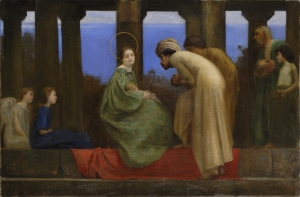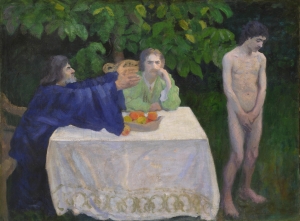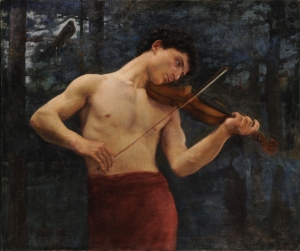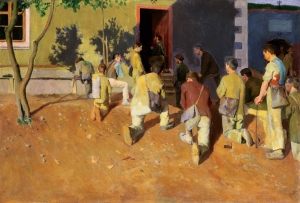Ferenczy Károly és a nagybányai mesterek művei
HIT−MÍTOSZ−KÖLTÉSZET
|
|
|
|
A kiállítás Ferenczy Károly és a nagybányai művésztelep alapító mestereinek biblikus és vallásos tárgyú képeiből, valamint mitológiai és irodalmi ihletésű műveiből ad reprezentatív válogatást. A remekművek sokaságában bővelkedő tárlat témaválasztásában tisztelegni kíván Balatonfüred, e jelentős kultúrtörténeti hagyományokkal rendelkező város történelmi és művészeti – irodalmi, színházi, egyházi – öröksége előtt is. A hazai képzőművészet modernizációját megindító, 1896-ban alapított nagybányai művésztelep a Hollósy Simon festőművész nevével fémjelzett müncheni tanítványi és művészbaráti körből nőtt ki. A rokon világlátású művészek együttes fellépése ellenpontot jelentett az akadémizmus egyeduralmával, valamint a hivatalos művészeti intézményekkel szemben. A kolónia mesterei egymást támogató munkájukban elsősorban a művészi minőség fontosságát emelték ki, de a legtöbb alkotóra jellemző volt a társadalmi problémákra való fogékonyság is. A szabad ég alatt született, napfénnyel átitatott képeikkel a nagybányaiak a festészet nyelvének korszerűsítésére vállalkoztak. Stiláris fejlődésük a naturalizmustól a hazai tájakon érlelődő plein-air és impresszionista szemléletmódig ívelt, és úttörő munkálkodásukkal a hazai képzőművészetnek az európai modernizmussal szembeni évtizedes lemaradását is behozták. Ferenczy Károly neve és életműve szinte egybeforrt a Nagybánya-fogalommal. Az impresszionizmus és posztimpresszionizmus hazai változatának megteremtésével a művészkolónia kiemelkedő alkotójaként, vezető mestereként a modern magyar festészet megalapozójává vált. |
|
|
A nagybányai alapító mesterek 1896 és 1903 között készült nagyméretű biblikus képei a vallásos festészet szekularizálódásának európai folyamatába illeszthetők. A Biblia világa nem szakrális céllal, hanem az alkotók művészeti nézeteinek metaforájaként jelent meg a műveken, a hagyományos vallási történetek kerettémául szolgáltak. Az Ó- és újszövetségi feldolgozások hátterében egy tágabb világkép, alapvető egzisztenciális kérdések sora állt. A bibliai történetek Ferenczy Károly életművében foglalták el a legnagyobb teret, korai nagybányai időszakában szinte évente festett egy-egy jelentős biblikus képet. A természeti látvány élménye képein összecsendült régmúlt eseményekkel, a valóság kapcsán felötlő szakrális történetek sorát hívva elő. A legelső nyáron 1896-ban festett emblematikus műve, az alkotóközösség bensőséges összetartozását jelképező A hegyibeszéd The Sermon on the Mount, melyen fia, Ferenczy Valér szavaival: „Krisztus tanításának korokon, népeken, tér- és időhatárokon túl ható, terjedő jelentősége” jut kifejezésre. A sűrű erdő mélyébe helyezett Ábrahám áldozata The Sacrifice of Abraham festésekor pedig Ferenczy panteista természetszemléletéből kiindulva a művészi képzelet és az ószövetségi jelenet költői szintézisét hozta létre. 1907-ben született A tékozló fiú The Prodigal Son, melyen a művész nagybányai kertjének miliőjébe, az árnyas diófa alá helyezte a Lukács evangéliumából ismert történetet. Ferenczy Károly 1914-ben festette utolsó bibliai témájú képét a Pietàt Pietà, melyet utóbb feldarabolt, mivel elégedetlen volt az eredménnyel. A kép mellé társított grafikai vázlatok sora bepillantást enged a művész munkamódszerébe; fáradtságot nem ismerő elmélyülésébe, a tökéletesedés felé törő útkeresésbe. |
|
|
A nagybányai művészek történeti jeleneteivel rokon mitológiai motívumok rendre felbukkannak a képeken. A festők hol a régi görögök mitikus históriáiba, hol pedig a magyar őstörténet kalandos múltjába kalauzolják a nézőt. Ferenczy Károly: Orfeusz Orpheus vagy Thorma János: Dione és Zeusz Dione and Zeus antikvitást idéző kompozíciói békésen megfértek Iványi Grünwald Béla, a hun-magyar mondavilágot életre keltő Hadúr kardja The Warlord’s Sword című festményével. A kiállításon a nagybányai művésztelep első évtizedére koncentrálva az alapító mesterek irodalmi vonatkozású művei is helyet kaptak. A festőművészek szépirodalmi fogékonyságát a müncheni Hollósy-kör kulturális légköre alapozta meg; elsősorban a nemzetközi realista-naturalista írók műveinek ismerete és tisztelete. A nagybányai letelepedést követően a festőkolónia tagjai a haladó irodalmi körök, a kortárs magyar írók felé is kapcsolatokat találtak. Az azonos világnézeti tartalmak és rokon esztétikai ideák mentén kibontakozó barátságok elsősorban irodalmi vonatkozású művekben, illusztrációkban és portrékban öltöttek testet. A nagybányai mesterek által illusztrált szépirodalmi művek közül kiemelkednek Kiss József 1897-ben napvilágot látott versei, Bródy Sándor 1898-ban megjelent Az ezüstkecske The Silver Goat című regényének díszalbuma, valamint Vörösmarty Mihály költeményeinek 1904-ben kiadott kötete. Az irodalmi, a biblikus és a mitologikus motívumok gyakran összefonódnak a nagybányaiak képein; az illusztrációk sorába olykor bibliai témák keverednek ‒ Réti István: Vén Jób Old Jobe ‒, néhol pedig mitológiai jelenetek vegyülnek ‒ Ferenczy Károly: Daphnis és Chloe Daphnis and Chloé. |
|
A Vaszary Villa bemutatójának gerincét a Magyar Nemzeti Galériából kölcsönzött képek alkotják, de a szentendrei Ferenczy Múzeumból valamint a Kiscelli Múzeumból is érkeztek művek a tárlatra. A közgyűjteményi anyagot két magángyűjteményi remekmű is kiegészíti. A kiállításon Ferenczy Károly 19 reprezentatív festményét és 10 grafikáját is bemutatjuk, társítva a nagybányai művésztelep mestereinek ‒ Hollósy Simon, Réti István, Iványi Grünwald Béla, Thorma János, Glatz Oszkár, Csók István és Koszta József ‒ 21 művével, valamint az illusztrációkkal teli irodalmi albumokkal. A kiállítás koncepcióját kidolgozta, a műveket válogatta és a kiállítást rendezte: |
|
BELIEF – MYTH – POETRY
|
|
|
|
The exhibition provides a representative selection of Biblical and religious pictures and of the paintings inspired by mythology and literature painted by Károly Ferenczy and the founding masters of the Nagybánya Artist Colony. In its choice of topic, the exhibition abounding in masterpieces wishes to pay tribute to the historical and artistic – literary, theatrical, religious – legacy of Balatonfüred, which has rich cultural traditions. The Artist Colony of Nagybánya, which was founded in 1896 and initiated the modernization of Hungarian visual arts, grew out of the circle of friends and disciples of the artist Simon Hollósy. The cooperation of artists with similar world views and their common actvity was a counterpoint to the monopoly of academic art and to the official art institutions. The masters of the colony emphasized the importance of artistic quality in their work supporting one another, but most artists were also responsive to social problems. With their en plein air, sun-lit pictures, the artists of Nagybánya undertook the modernization of the language of art. The span of their stylistic development was from naturalism to plein-air, maturing in the Hungarian countryside, and impressionism, and with their pioneer activity, they compensated for the decade-long drawbacks Hungarian art had as compared to European modernism. |
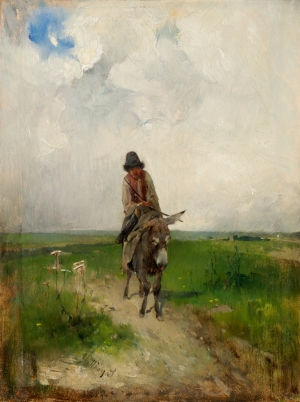 |
Biblical stories were mostly typical of Károly Ferenczy’s art, in his early Nagybánya peroid he painted a significant Biblical painting almost every year. In his pictures, the experience of nature harmonizes with stories of the ancient past, evoking a series of sacred stories inspired by reality. Mythological motifs related to history scenes often appear in the paintings of the Nagybánya masters, in which the viewer is sometimes taken to the mythological history of ancient Greece, at other times to the adventurous prehistory of the Hungarians. With respect to the first decade of the artist colony of Nagybánya, at the present exhibition the paintings with literary references of the founding masters are shown as well.The susceptibility of the artists to literature was grounded by the cultural atmosphere of the Hollósy-circle in Munich, primarily the knowledge of and respect for the internationally renowned realist-naturalist authors like Zola, Maupassant, Tolstoy and Ibsen. Following the settlement in Nagybánya, members of the artist colony made contacts with progressive literary circles and contemporary Hungarian writers. Friendships made along identical world views and related aesthetical ideas were embodied first and foremost in paintings, illustrations and portraits connected to fiction. From among the literary works illustrated by masters of Nagybánya the most outstanding ones are the poems of József Kiss published in 1897, The Silver Goat, a de luxe edition of Sándor Bródy’s novel from 1898 and the 1904 edition of Mihály Vörösmarty’s poems. |
|
Most of the paintings exhibited in the Vaszary Villa have been borrowed from the Hungarian National Gallery, but the Ferenczy Museum of Szentendre and the Museum of Kiscell have also contributed to the show. Two masterpieces from private collections have also been added to the paintings from the public collections. 19 representative paintings and 10 graphics of Károly Ferenczy are exhibited accompanied by 21 works of the artists of Nagybánya -Simon Hollósy, István Réti, Béla Iványi Grünwald, János Thorma, Oszkár Glatz, István Csók and József Koszta- and literary albums full of illustrations. The concept of the exhibition was designed, the works were selected and the exhibition was arranged by Edit Plesznivy, the chief museologist-art historian of the Hungarian National Gallery |
|

